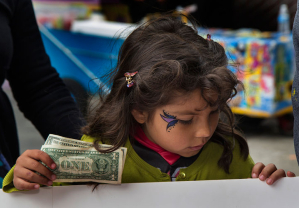
Silicon Valley in California is famous worldwide for its propensity to innovate in the technological, digital world and is home to tech giants Google, Apple and Facebook. However, it is also home to endemic poverty that affects many young children there.
According to an opinion article written by John D. Sutter for CNN, even Silicon Valley hasn't escaped the scourge of child poverty that has afflicted many parts of the United States. He visited the area in November after CNN viewers voted for him to do a story on the topic.
"There, I found children living in tents, homeless shelters -- even a garage, which I found particularly ironic given that Google and Apple link their company origins to garages in this valley south of San Francisco," Sutter wrote.
Robbie Couch of the Huffington Post elaborated on the stories of some of the impoverished children in Silicon Valley. One of them included 16-year-old Jorge Valencia, who claimed that his family often lived on just $2 a day.
"There's like, an invisible boundary around ... eastside San Jose," Valencia said to Sutter. "They don't even see you as humans. They think you're trash, or peasants, or less."
CNN reported on an interactive website that California's Silicon Valley is one of the wealthiest places in the United States. In terms of median household income, San Mateo and Santa Clara Counties had $88,202 and $91,702 respectably, while the average U.S. income was at $53,046.
"Many people think that here in Silicon Valley, which is such an affluent area, hunger really isn't a problem," Second Harvest Food Bank CEO Kathy Jackson said. "It shouldn't be a problem, but it is a problem."
Jackson told Couch that children were not the only ones suffering from poverty in Silicon Valley. Other people who have asked for help from her organization included employed parents unable to make ends meet with minimum wage jobs, single mothers and unemployed professionals who lost their job in the "Great Recession."
Couch reported that based on information gathered by Second Harvest Food Bank, about one in three kids in the San Jose area struggled with hunger.
"Child poverty is nearly invisible here - but it does exist," Sutter wrote, citing an example of a house in Silicon Valley where 16 people, including 11 children, lived.
One of those children, 16-year-old Angelina, lived in that house.
"We had to turn the living room and garage into rooms in order for everyone to fit," Angelina said.
Sutter reported that Silicon Valley highlighted the "tale of two Americas."
"This country - with a GDP of $16.8 trillion - has the developed world's second highest rate of child poverty," Sutter wrote, citing statistics from UNICEF. "Only Romania is worse."
Despite the fact that one in five kids in the U.S. lived below the poverty line, Sutter contended that this problem can be fixed. He thought it would be better to present solutions as opposed to going into a tirade "about all that's wrong with Silicon Valley and this country as a whole."
"Child poverty isn't inevitable," Sutter wrote. "It's a choice, and we can choose to end it."
Sutter presented four possible solutions to tackling child poverty. They included boosting housing subsidies, raising the minimum wage, investing in preschool and child care, and giving poor families cash.
"Housing is too expensive for poor families, especially in markets such as Silicon Valley," Sutter wrote. "But making affordable housing more available can reduce this burden."
Sutter cited statistics from a 2015 Children's Defense Fund report that argued 2.3 million children could be lifted out of poverty if federal housing subsidies were increased. This action would reduce U.S. child poverty by 20.8 percent.
Sutter then tackled the issue of raising the minimum wage. He cited data from the Congressional Research Service showing that when adjusted for inflation and using July 2013 dollars, the federal minimum wage was worth $9.27 an hour back in 1963; the current rate stands at $7.25 an hour.
"Raising the federal minimum wage to $10.10 per hour, and boosting the tipped worker wage to $7.07, could reduce U.S. child poverty by 4 percent, according to the Children's Defense Fund report," Sutter wrote. "That would help lift 400,000 American kids out of poverty."
Sutter argued that investing in preschool and child care helps society as a whole. He cited the Children's Defense Fund report, which contended that "spending $5.3 billion would reduce U.S. child poverty by 3 percent, or 300,000 kids."
"Despite advances in many states, only 40 percent of 3-year-olds are enrolled [in the U.S.]," Sutter wrote, noting that in comparison, Iceland had a low child poverty rate and universal enrollment in early education starting at two years old.
Finally, Sutter suggested that giving poor families cash would help alleviate poverty. He cited the example of a Cherokee tribe in North Carolina that paid its members a biannual stipend "just for being alive"; the money came from a tribe-owned casino.
"For the poorest families, a yearly $4,000 payment reduced by 22 percent the odds that children would commit minor crimes by their late teens," Sutter wrote. "The poorest kids were one grade year ahead when researchers checked in with them at 21."
Sutter added that mental health improved as well, noting that children lifted out of poverty "saw behavioral problems decrease by 40 percent."
Whatever solutions end up being pursued, San Jose Mayor Sam Liccardo thought the poverty rate was morally repugnant.
"This is the moral shame of our community," Liccardo said in regards to extreme poverty among children. "It is incredibly challenging to be a child growing up in poverty in this valley. There simply aren't the support systems in place to ensure those kids can thrive."







